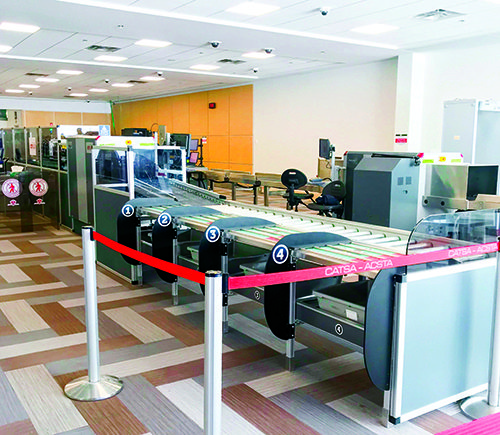When Halifax Stanfield International (YHZ) recently expanded its security checkpoint, the Nova Scotia airport leveraged the associated construction process by dovetailing additional projects to add space for airline operations and new passenger concessions. Crews completed the security enhancements last spring and the other expansions this summer.
When Halifax Stanfield International (YHZ) recently expanded its security checkpoint, the Nova Scotia airport leveraged the associated construction process by dovetailing additional projects to add space for airline operations and new passenger concessions. Crews completed the security enhancements last spring and the other expansions this summer.
 Airport officials report that the primary mission of the $17 million Passenger Processing Terminal Expansion project—installation of CATSA Plus screening technology—has dramatically increased throughput and enhanced the passenger experience at the airport’s checkpoint.
Airport officials report that the primary mission of the $17 million Passenger Processing Terminal Expansion project—installation of CATSA Plus screening technology—has dramatically increased throughput and enhanced the passenger experience at the airport’s checkpoint.
Joyce Carter, YHZ’s president and chief executive officer, notes that all components of the recent terminal expansion provide for better customer service. “We saw a clear opportunity to elevate the passenger experience not only at pre-board screening with new CATSA Plus technology, but also post-security in our holdroom,” she explains. “Expanding the terminal building allowed us to take the Halifax Stanfield experience to the next level.”
|
Project: Passenger Processing Terminal Expansion Location: Halifax Stanfield Int’l Airport, Nova Scotia Primary Benefit: Enhancing passenger checkpoint with new CATSA Plus security technology Concurrent Efforts: Adding operational space for airlines; improving gate seating & concessions Total Cost: $17 million (does not include cost of screening equipment which was paid for by CATSA) Construction: Sept. 2017-Summer 2019 Design Consultant: WSP Builder: Lindsay Construction Flooring; Forbo Flotex Seagrass Checkpoint Equipment: Mach-SmartLane purchased by CATSA from L3 MacDonald Humfrey Automation |
As Atlantic Canada’s principal full-service airport, YHZ provides access to North America, Europe, Asia and the Middle East. Passenger traffic has steadily increased in recent years, and last year jumped 5.6% to 4.3 million travelers.
Growing volume put a heavy burden on the pre-board domestic/international security checkpoint. “Wait times were getting to be a concern, and we knew our maximum capacity was approximately 720 passengers per hour,” says Dean Bouchard, director of planning and infrastructure for the airport. “During peak season and peak times, we were approaching that number and needed to add additional capacity.”
Two things were certain: Terminal space was at a premium, and improvements would require substantial construction. As the airport strategized, CATSA rolled out its new CATSA Plus screening system, which provides more efficient screening via fewer, but longer, lanes. YHZ opted to increase the size of the checkpoint to install CATSA Plus lines, and significantly reduced its checkpoint wait times after less than six months of use.
“With this additional capacity, we’re seeing results that are already better than predicted,” Bouchard reports. The four CATSA Plus lines provide the screening capacity of eight standard lines.
The Canadian Air Transport Security Authority is a Crown corporation responsible for securing specific elements of the air transportation system—from passenger and baggage screening to screening airport workers.
Reducing Security Queues
Previously, YHZ had six lanes that were 13 meters long each. Now, it has four CATSA Plus lanes, each stretching for 28 meters. The lanes themselves are 21 meters long, plus 7 meters for queue space at the front and back for passenger flow.
 Because the passenger checkpoint is located adjacent to the aircraft apron, the airport had to extend its terminal footprint by 12 meters onto the apron to accommodate the longer lanes. Overall, the extension was about 90 meters long.
Because the passenger checkpoint is located adjacent to the aircraft apron, the airport had to extend its terminal footprint by 12 meters onto the apron to accommodate the longer lanes. Overall, the extension was about 90 meters long.
CATSA Spokesperson Christine Langlois notes that the new lanes combine the latest equipment, technology and processes that have been successfully tested at various airports over the last few years.
“The new CATSA Plus concept involves replacing standard screening lines with high-performance lines, while also addressing CATSA’s vision for seamless security,” says Langlois. “The ‘plus’ represents enhanced security effectiveness and a more pleasant experience through the checkpoint for air travelers, as the new lines allow for improved customer service and passenger flow.”
One visible feature of the new system is parallel divest stations, which permit up to four passengers to place their belongings in bins at the same time. This allows faster, more experienced travelers to move through the checkpoint quickly, while slower passengers can take their time without being rushed. Conveyor belts for the X-ray machines run continuously to further reduce slowdowns.
 “Images are sent to the screeners in a nearby room; and whatever screener is available to look at an image takes it,” Bouchard explains. “That actually moves the bags through the screening process more quickly as well.”
“Images are sent to the screeners in a nearby room; and whatever screener is available to look at an image takes it,” Bouchard explains. “That actually moves the bags through the screening process more quickly as well.”
The system also allows screening officers to reject bins and redirect them to a separate search lane for additional screening. Motorized rollers automatically return empty bins to the front of the line, eliminating the need for officers to manually perform the task.
A bin tracking system assigns a unique ID tag to each bin, and a camera photographs each bin before it enters the X-ray machine. Photos make it easier for officers to identify items during the inspection process.
At the end of the lanes, an expanded area with more benches and tables makes it easier—and faster—for passengers to repack their belongings and continue their journeys.
Additional Objectives
The recent expansion also increased operational space for airlines and concession offerings for passengers.
“While the heart of the project was to create more capacity for screening, we also recognized that airlines would have a need for additional airside space for apron operations in the next three to four years,” explains Bouchard. “We took advantage of the fact that we were undergoing construction so the space could accommodate those uses as well.”
Air carriers gained square footage adjacent to the ramp for operational equipment, maintenance and supplies. And project planners extended the level above it to expand the hold area for three gates. “The initial need was on the ground floor; but because we were expanding the building, we decided to expand both floors,” Bouchard relates. “The larger footprint offered an excellent opportunity to also expand the holdroom on the second floor of the terminal, turning what would have been the roof of the ground floor expansion into the floor of the holdroom expansion.”
The airport is using the new second-floor space to add concessions in a once-underserved area of the terminal. Previously, the hold area for gates 16, 18 and 20 only had seating. The new space will have refurbished seating and five new concessions, with both retail and food/beverage options. Two concessionaires have already taken root: the Firkin & Flyer Pub and Metalsmiths Sterling. Airport officials are in discussions with other concessionaires about the remaining three spaces.
“Because the airport has been expanded in phases since 1960, the three gates that are specifically affected by this seating area were a little bit crowded,” Bouchard notes. “With this expansion, we were able to distribute the seating and make a nicer ambiance for the passengers. And the concessions now allow people at the gates to get food and drink without having to walk very far.”
In addition, the airport plans to add soft, bench-style modular seating in the area. “Soft seating will liven up the area,” Bouchard notes. “It’s more flexible in terms of how people use it.”

An art program is another planned addition. “As we look at the new space, we see we have a lot of canvas to work with,” he remarks.
Overall, Bouchard considers the expansion/renovation a big success: “The processing of our pre-board screening facility reduced wait times and eliminated excessive queues. The ground floor expansion provided us with space for future requirements for airside operations. And on top, we expanded our holdroom, allowing for a better passenger experience with additional and more convenient concessions.”
Heavy coordination and planning helped minimize disruption to operations during construction, he adds. “The area is a central and busy part of the terminal as it is adjacent to one of the bag halls. There was a time during construction where we had to reduce gate access, so it was important to carefully plan.”
As CEO, Carter emphasizes how the expansion project supports the airport’s long-time focus on providing the best passenger experience possible. “At Halifax Stanfield, we’re known for customer service excellence,” she remarks, citing the airport’s volunteer Tartan Team and self-serve bag drops as two of many specific examples. “Based on customer feedback, the terminal expansion is an investment that will enable us to better serve our passengers and airport partners now and in the future.”


 facts&figures
facts&figures

